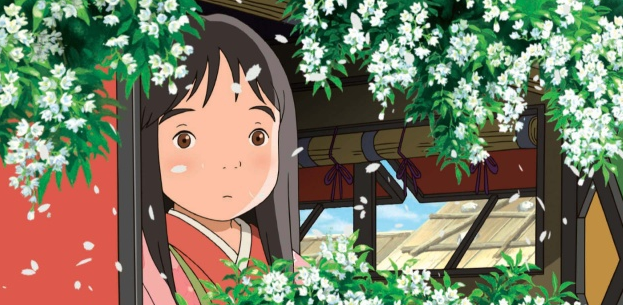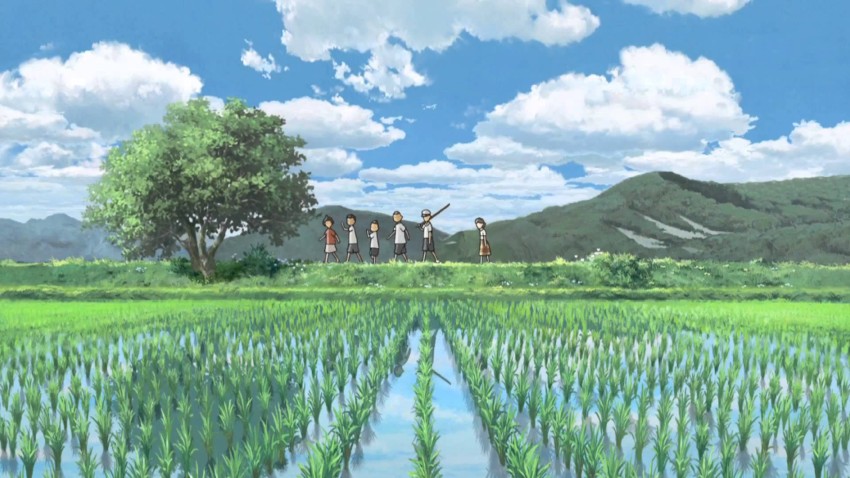Period Pieces: Mai Mai Miracle
June 12, 2018 · 0 comments
By Andrew Osmond.
 The story of Mai Mai Miracle takes place in a very specific time, 1955, with some excursions back a millennium into the past. The film’s setting is Hofu, a coastal city in Yamaguchi prefecture at the bottom of Japan’s main island, Honshu. As the script mentions, in previous centuries the area used to be a province called Suo.
The story of Mai Mai Miracle takes place in a very specific time, 1955, with some excursions back a millennium into the past. The film’s setting is Hofu, a coastal city in Yamaguchi prefecture at the bottom of Japan’s main island, Honshu. As the script mentions, in previous centuries the area used to be a province called Suo.
It’s notable that the characters in Mai Mai Miracle talk of Japan’s centuries-old past, but hardly ever refer to the country’s recent history – namely, World War II. The sole comment is made early on by Shinko’s grandfather Kotaro: “It’s ten years after the war, but that’s nothing compared to a history of a thousand years.” There are no urban bombsites, and the main characters are kids born after the war, for whom ten years might as well be a hundred.
Instead, Mai Mai Miracles’s setting feels like a sliver of Japan, brief as blossom, after the horror of war but before excess modernisation. This is a place of horses and carts, of children playing unsupervised in clean fields and streams. The only screen is to be found in the one-room cinema (with a real projector, of course). Radio is the dominant home entertainment; TV is almost unknown. In 1955, television was a hugely expensive luxury in Japan, and only broadcast for five hours a day.
Mai Mai Miracle shows vendors selling ice blocks for refrigerators, or travelling with explosively loud steam machines turning corn into popcorn. Silk is a flourishing country industry, hence the huge number of mulberry fields. However, there’s already post-war industrialisation. We see that the factory complex where Kiiko’s dad works provides luxury new homes for its employees. Today, Hofu’s real industrial seaport provides many local jobs.
A couple of details in Mai Mai Miracle need more explanation. In the film, when Shinko follows Kiiko home, they pass a kamishibai (“paper theatre”) storyteller performing to a group of children. These performers told stories through a series of small painted boards mounted in a frame, which were pulled out one by one as the story continued. The tales often featured wild superhero characters, like the skull-headed Ogon Bat, who predated Superman and Batman.
 Of course, it was the kamishibai storyteller’s job to provide a bombastic narration, tempting children to come back for the next episode. But by 1955, kamishibai was nearly over as mainstream entertainment. In the next years, television ownership would grow at speed, and kamishibai would be gone except as a museum piece. It’s often seen as a precursor to manga and anime, with some of its practitioners moving into those fields.
Of course, it was the kamishibai storyteller’s job to provide a bombastic narration, tempting children to come back for the next episode. But by 1955, kamishibai was nearly over as mainstream entertainment. In the next years, television ownership would grow at speed, and kamishibai would be gone except as a museum piece. It’s often seen as a precursor to manga and anime, with some of its practitioners moving into those fields.
There are also a couple of references in the film to “Glico” prizes. Glico was, and is, a caramel candy that comes with a toy – similar to Italy’s Kinder Surprises or Kinder Eggs. Originating in the 1920s, the Glico sweet was revived in post-war Japan, hugely popular when food could still be short. Glico has long had a nostalgic cachet in Japan. In 2001, the brand was brought back as “Timeslip Glico.”
There are also imports glimpsed in Mai Mai Miracle. Kiiko, we see, has many translated works of western children’s literature. The cinema shows an American “Western” film, with Japanese subtitles. (We glimpse the romantic hero kissing his girl in a most un-Japanese way.) Japan’s post-war years saw a glut of imported Hollywood films hit cinemas, against which the local product struggled. Japanese animation, for example, was most confined to TV commercials.
It should be noted, though, that the most prominent import in Mai Mai Miracle is a blatant anachronism! The film’s last scenes are accompanied by an (English-language) cover of “Sing,” a maddeningly catchy children’s song. It includes the lyric, “Don’t worry that it’s not good enough for anyone else to hear,” summing up karaoke in one short phrase. “Sing” was written by Joe Raposo for America’s Sesame Street programme in 1971 – sixteen years after Mai Mai Miracle’s purported timeframe. The song was popularised by The Carpenters in 1973; a year later, the group created a Japanese-language version in Osaka.
But Mai Mai Miracle isn’t the first Japanese animation to play loose with the period. Hayao Miyazaki’s classic 1988 Japanese animation My Neighbour Totoro was also supposedly set in 1950s Japan. According to the documentary The Birth of Studio Ghibli, the first pitch was initially rejected by Tokuma (Ghibli’s corporate backer) because, “The post-war period [in Japan] still had a strong image of poverty and hardship.” Of course, the film was eventually made, with the result that Japanese viewers are now likelier to associate 1950s Japan with Totoro.
However, Miyazaki himself said that Totoro’s date hardly mattered, and “purposely got rid of” most specific cultural details in his film. For instance, Miyazaki considered featuring a contemporary swordplay radio drama in Totoro, like the one Shinko listens to in Mai Mai Miracle. However, Miyazaki finally opted against it. For him, the only necessary condition of Totoro was that it was “set in a time before television.”
But since Totoro, there have been many films set in Japan’s recent past, with abundant nostalgic references. They include two later Ghibli films, Isao Takahata’s Only Yesterday and Goro Miyazaki’s From Up on Poppy Hill, which both look back to the 1960s. So does the television anime Kids on the Slope, while the live-action film trilogy Always: Sunset on Third Street spans 1955 to 1965. The trend was even spoofed in a cartoon, Crayon Shin-Chan: The Adult Empire Strikes Back. Made by the future Miss Hokusai director Keiichi Hara, it shows adults being brainwashed and infantalised by their nostalgia for the good old days.
However, Mai Mai Miracle does not present its past as a utopia. There is illness and death in the film, and fathers who abuse their sons. The bad side of 1955 is laid out in a vision of Hofu’s port in the last act, full of drunks, floozies and revelling Americans. These Americans are another oblique reference to the legacy of Japan’s defeat and occupation, which had ended three years earlier.
Mai Mai Miracle’s director Sunao Katabuchi would later present another side of history. If Mai Mai says nothing about the war, then his In This Corner of the World faced it directly; it’s about characters living in Hiroshima prefecture during World War II.
Andrew Osmond is the author of 100 Animated Feature Films. Mai Mai Miracle is available in the UK from Anime Limited.
anime, Hayao Miyazaki, history, Japan, Mai Mai Miracle, My Neighbour Totoro, Sunao Katabuchi
Leave a Reply